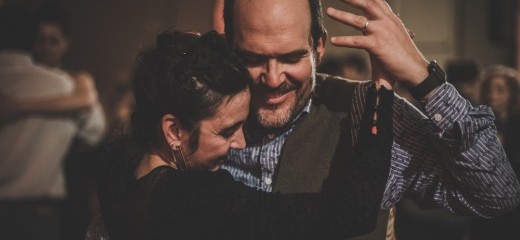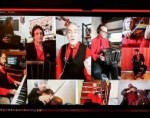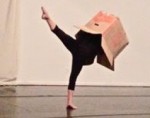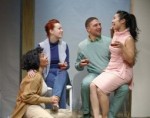
When Will We Embrace Again?
by Carolyn Merritt
“In times of crisis we should all be diarists and documentarians.”
-Paul Theroux, New York Times, April 5, 2020
I flip back through my calendar, as if walking a sounding line horizontally in time. Day by day, I measure the distance from a world of social distancing to a time before, when a night out meant hugging one friend or stranger after another and dancing together for 10 minutes, over and over again, every moment of it new in Argentine tango’s constant improvisation. Nineteen days ago my son stopped going to school. Six days before that I bumped into a friend in the market and we joked over our carts of frozen foods. Six days earlier, I attended a milonga where all seemed well, normal even, despite talk of the virus. An eerily empty milonga later that week (29 days ago) foreshadowed the full-scale canceling of social life to come.
"Tango was on a different timeline.”
-Meredith Klein, tango dancer and director, Philadelphia Argentine Tango School
In early March, hand sanitizer occupied a prominent spot in the entryway of the Philadelphia Argentine Tango School. By the time I dropped in on a group technique class on March 9, we danced without touching. A local dancer and nurse conducted health screenings at the milonga on March 11, where strict hand washing and sanitization protocols were enforced. By March 15, director Meredith Klein officially closed the school and canceled two big upcoming events, a March tour to Buenos Aires and the 10th Philadelphia Argentine Tango Festival in May.
Klein highlighted the global tango network as a crucial source of information in the absence of a coherent narrative from U.S. authorities. From late February, NYC-based professionals shared their experience and advice via social media, while in early March, organizers in Buenos Aires decided to impose a 14-day quarantine on foreign visitors before allowing their participation in the city’s tango events. As tango events across the globe shut down and genres of dance instruction shifted online, Klein similarly began offering classes and a lecture series via Zoom. These virtual offerings replace only 10% of the school's lost income, but they do help to keep community members connected to the school and to one another.
“Nothing is a substitute … tango is in a different category.”
-Lucille, social dancer and personal chef
I’ve gathered online and chatted with friends and acquaintances about how they are experiencing tango’s absence in the last month. Several reported feelings of depression. English teacher and tango instructor Elly Fernandez confessed to feeling “unmoored [without the] creative life force,” that is tango. Outside my door, daffodils burst like sunshine from the earth and trees bloom a pastel canopy overhead, the short-sleeve temperatures warming my skin. Philadelphians embrace this weather, but in new ways: we don masks, dart our heads each way, dance the strange choreography of social distance as we brave sidewalks, streets, and urban garden plots. But, as Lucille lamented, outdoor activities like running, biking, and gardening don’t necessarily fill the void left by tango.
I wondered if listening to the music, watching films, or viewing favorite dancers’ performances might provide comfort, but several friends described the music as “painful” right now. On the other hand, some, like Argentine native and musician Gerardo Razumney, noted that they aren’t suffering. A regular fixture in Philly’s tango scene for decades, Razumney loves to dance, but unlike many, he came to tango through the music, and listening to tango was already part of his daily routine. Without milongas, hearing the music provides added pleasure while he engages in long-delayed home projects. Still others are seizing the pause to thoughtfully assess tango’s returns in exchange for its demands—on time, energy, ego, emotional and physical health. Nothing new among seasoned dancers, this downswing reflection speaks to the highs and lows of this intimate partner dance.
“To the degree that tango is addictive, there will be withdrawal.”
-Farrell Silverberg, psychologist
Addiction functions like a rite of passage in tango, a mark of seriousness. Unlike Buenos Aires, Berlin, or New York City, Philly doesn’t offer daily milongas, but between classes, practice events, and milongas, you can dance here several times a week. Travel to dance in other cities and countries is a part of life for many dancers, some of whom scrape and save in their day-to-day for the priceless experience of more ‘miles’ on the dance floor. Whether a pleasurable dance with a new partner in a new place or a chance to reunite with prized partners who are geographically distant, tanguera/os famously chase their next high. Among the seven women who joined a group video happy hour, one was missing a close-embrace tango Encuentro in Utah as we spoke; it was postponed until 2021, a source of some comfort, even as a June 2020 event got nixed too. Another had canceled a roster of trips to tango marathons and festivals most every weekend from March through July.
“I turn away when people go by now. How long will it take to overcome that fear?”
-Kristin Balmer, artist and tango teacher
I began to grasp the enormity of COVID-19 when a friend asked how long it would be before our children could hug their grandparents again, and I realized I couldn’t answer. Anyone who lived through the AIDS crisis might have an eerie sense of déjà vu now, recalling the fears of touch and intimacy which that earlier pandemic unleashed into our national psyche. Americans already have discomfort with personal space and physical contact, an issue Balmer raised as we pondered tango’s future. With all its rules and codes, she noted, tango offers the psychological benefits of touch in short-lived, socially sanctioned encounters, without the ties of commitment and thus with a certain amount of distance.
Klein stressed this in contemplating the business of tango. Distinct from competitive partner dance forms like ballroom, where students often learn to dance with one person, tango is social and improvisational to the core. Instruction follows suit. Students learn the structure and social codes of the dance, and they learn to apply this knowledge from moment to moment on the dance floor, improvising with anyone. The first step toward that end goal is group classes where partners rotate regularly, and thus force themselves beyond the steps to listening, to communicating with varied partners through the constant flow of improvisation.
Virtual Tango
In addition to online courses, lectures, and happy hours, several virtual milongas have popped up in the past few weeks. I attended two this past weekend—Earth Virtual Milonga, via Zoom, which featured DJs from Los Angeles, Stockholm, Boston, and Tokyo, and Milonga La Memoria, via Twitch, which features a different DJ each week. Zoom’s gallery view displayed a four-page full-screen grid of dancers tuning in from around the world. Many appeared solitary. Several danced alone or substituted a pillow or doll or animal for a partner. A lucky few were sheltering at home with a partner or friend who also dances. The chat space filled with greetings, expressions of gratitude for pets, happiness at seeing other couples embrace in the flesh. It made me smile even as it broke my heart. La Memoria shifted from the DJ’s computer screen playlist to a montage by tango photographer Steven Thull, and the evening also included a trivia contest, a performance by dancers Maja Petrovic & Marko Miljevic, and digital art rewards to encourage donations.
I need little more than music in the right circumstances to travel in my mind, and all the DJs were top notch, but engaging through a computer left me feeling empty. After we’d tuned in to both milongas, I chatted with Marty Katz, a Baltimore-based dancer and photojournalist, and he described the sorrow he felt watching Earth Virtual Milonga’s full-screen grid of global isolation, of potential loneliness writ large. Tango once held the promise of bringing us together to dance. The global community is a fairly middle- to upper middle-class group, and travel, especially to Buenos Aires, has united people who might never meet otherwise. The realization that these connections might never extend beyond the screen hit me hard.
I am happy these platforms arose to connect dancers and generate modest support for artists who, until recently, made their living in tango. Perhaps time will soften my resistance, warm me to the healing potential of tango without tactile human connection in real time and space. In my chat with psychologist Farrell Silverberg, he questioned the soullessness of digital tango, even as he argued that video would inevitably become a bigger part of tango going forward. Much like gamers who don suits with sensors, the next generation of tango dancers may increasingly look to virtual platforms for the highs I once chased from club to club, embrace to embrace, until the wee hours of the morning, again and again.
“At some point you have to take a risk, because you cannot stop living.”
-Gerardo Razumney
Among the many things I love about tango is its intergenerational character. This also causes me great anxiety these days—the inevitable loss to come. Even as that fear and trauma will stick with us, psychologist Silverberg predicts a rush back to tango on the other side of survival, marked by greater appreciation for its tactile, real-life soul. Razumney is among the most active octogenarians I’ve ever met. Though he left Argentina decades ago, he maintains a porteño schedule and lifestyle—dining in the middle of the night, staying up until 3 a.m., regularly attending concerts, gathering with friends, playing music, dancing. He takes the virus and the precautions seriously: he has been sheltered at home for weeks and he has no plans to emerge before it is safe. He finds Trump’s prioritization of the economy over public health infuriating, even as it is clear that to live like this forever would be a kind of death.
Artist Samara Talkin got me laughing, remotely, with her analysis of the fetishistic, cult-like nature of tango. She raised the possibility that tango might adopt healthy safety guidelines, in much the same way that fetish communities devise strict protocols to protect members. Our happy hour crew pondered the implications of sharing test results or vaccination records in a world where HIPAA meets COVID-19 meets tango. Tango is not sexual but it is often intensely sensual. In a good dance with the right partner, you share their breath, feel their heart beat, allow their sweat to drench your face and soak your clothing. How can we possibly dance again without a vaccine?
Vaccine or no, this virtual moment may yield larger shifts in tango. Artist and tango teacher Kristin Balmer suggested tango might become more externalized and choreographic, like competitive ballroom, while the intimate, emotional aspects that brought so many of us to milongas might fade. In a quick conversation with Barbara Kountouzi, an adherent and teacher of nuevo close embrace, I sensed the worry in her voice—for her, the constant chest-to-chest connection of that embrace is tango. Perhaps selfies, Instagram, our constant curation and presentation of self via social media have prepared us for this moment. But can painting your toes and face, strapping on stilettos and squeezing into a hot number to strut in the mirror ever feed your soul?
“Déjame que llore crudamente, con el llanto viejo del adiós” (Let me cry like a child, with the long ago tears of goodbye)
-from Yuyo Verde (tango), lyrics by Homero Expósito
One of its more recent, exciting developments since tango’s late 1980s renaissance has been the rise of new orchestras who are not only reinterpreting classic tangos but also writing original compositions. As in tango’s Golden Age (1920-1950), live music is returning to milongas in Buenos Aires and some other cities. We have been blessed to witness this in Philly, where Klein has invested blood, sweat, and tears to bring musicians from Argentina to play at her events, and to promote the development of a New York-based orchestra, the Típica Messiez, who had been scheduled to play two nights of the 10th Philadelphia Argentine Tango Festival. The losses ripple out.
Last Tangos
Looking back to life before, my last tangos send back sweaty, joyful memories of embracing friends and moving together in time and space. Measured in time, the distance is a month—translated to feeling, its depth is immeasurable. I am one of the lucky ones to live with a partner who dances. We’ve enjoyed the novelty of online events, but the format feels like a placeholder, my engagement an investment back in the thing that fed me for so long.
Tango nearly disappeared during a thirty-year period of decline, between the 1950s and 1980s, only to blossom anew, captivating audiences and attracting pilgrims from around the world. Outside, the ground softens and we plant seeds. I click the tango happy hour link, and lean into this season of hope.
By Carolyn Merritt
April 14, 2020









